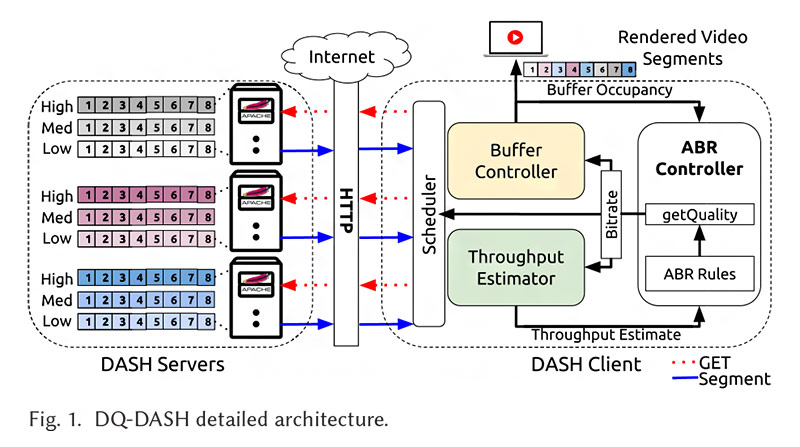In response to the growing demand for high-quality video streaming, particularly in the realm of HTTP Adaptive Video Streaming (HAS), notably Dynamic Adaptive Streaming over HTTP (DASH), the expectations of users have risen significantly. Meeting these Quality-of-Experience (QoE) requirements while navigating often congested network infrastructures presents a considerable challenge for content providers. Unlike conventional single-server DASH approaches, this research introduces Distributed Queuing theory for DASH (DQ-DASH). DQ-DASH leverages the simultaneous use of multiple servers for segment downloads, with the primary objective of enhancing quality stability, fault tolerance, and fairness in QoE.
The Problem
Traditional single-server DASH setups can result in unequal QoE experiences when clients share different servers or encounter bottlenecks within the network. Existing solutions that harness multiple servers often rely on server-side support or intricate network modifications. DQ-DASH, on the other hand, seeks to tackle these issues through a client-driven and distributed methodology.
The Solution
DQ-DASH adopts a bitrate selection algorithm grounded in Mx/D/1/K queuing theory. This algorithm takes into account throughput from multiple servers, current buffer occupancy, and the total buffer capacity. The ultimate aim is to elevate QoE, sustain video quality stability, and ensure equitable quality distribution by harnessing the capabilities of multiple servers in parallel.

Key Contributions
This research demonstrates several noteworthy contributions:
- DQ-DASH aligns seamlessly with DASH ISO/IEC standards, eliminating the need for custom video codecs or server-side API alterations. All servers function as stateless HTTP storage servers.
- DQ-DASH exhibits the potential for up to a 33% enhancement in QoE, with minimal variations among clients in comparison to sequential single-server downloads.
- DQ-DASH proves robust against server bottlenecks and variable network conditions, requiring only one additional segment download to verify server status in bottleneck scenarios.
- The study conducts an in-depth analysis of the interplay between segment duration, the number of servers, and maximum buffer capacity, offering valuable insights for optimal performance.
- DQ-DASH consistently outperforms both sequential single-server DASH and CDN-based load balancing rules across various experimental scenarios.
- Real-world testing employing a distributed DASH dataset validates the effectiveness of DQ-DASH.
- DQ-DASH demonstrates scalability through successful testing involving 100 clients sharing four servers in parallel across various network configurations.
Conclusion
DQ-DASH emerges as a promising solution to the challenges encountered by single-server DASH and existing load balancing rules. By leveraging queuing theory and a distributed approach, DQ-DASH enhances video streaming performance, ensuring fairness and robustness in QoE. These findings pave the way for improved video delivery, even within bandwidth-constrained environments, positioning DQ-DASH as a valuable addition to the ever-evolving landscape of adaptive video streaming technologies.